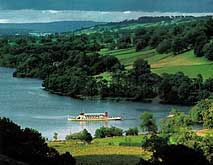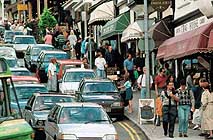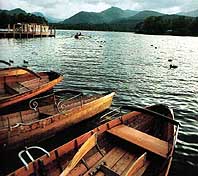A small, gleaming jewel in an island of natural treasures,
England’s Cumbrian heartland is the domain of sky-lacquered lakes, glacial
valleys, and chiselled peaks. Stone Age farmers, Celtic peoples, and invading
Norsemen cleared the Lake District’s ancient forests and tempered the
wilderness with lush, park-like pastures. Those steely grey skies, daubed with
sunlight, cast shadows on the shores of Ullswater, one of 16 major lakes that
give England’s Lake District its name. A remote area of rare and potent
beauty, 200 years ago, to Englishmen from the cities, the Lake District was
regarded as distant and forbidding; a wilderness, an untamed land. On a tour
of England in the 1720’s, novelist Daniel Defoe dismissed the region as the,
‘wildest, most barren, and frightful of any that I have passed over in
England”.
 The
shores of Ullswater reveal the majesty of England’s Lake District.
The
shores of Ullswater reveal the majesty of England’s Lake District.
Nowadays, a century old steamer carries visitors through
scenery that drove the poet Samuel Taylor Coleridge to sublime distraction.
Unlike Defoe, Coleridge found the district enchanting. “My glass (mirror)
being opposite the window, I seldom shave without cutting myself,” he wrote
of a stay in the district more than two centuries ago. “I offer soap and
blood daily, as an Eye servant of the Goddess of Nature”. And if any one
single person can be said to be responsible for the special place this
Lakeland holds in English affections, it is the poet William Wordsworth, who
drew inspiration for much of his work in this marvellous landscape.
 Not
all rustic hinterland, Bowness, on Lake Windermere is a thriving tourist hub.
Not
all rustic hinterland, Bowness, on Lake Windermere is a thriving tourist hub.
Windermere is the largest and most celebrated of the Lake
District’s lakes. The number of lakes is made out to be 16, but actually it
is a matter of definition. The region is packed with hundreds of bodies of
water, relics of the last ice age, 10,000 years ago, but most are deemed too
small to be called lakes, and are referred to locally in the old Norse word,
tarns. The peace and elegant beauty may not be as dramatic as the Alps or the
Himalayas, but this region is ‘user friendly’, with plenty of things to
do. In fact, it is often called England’s ‘favorite backyard’.
 Motorboats
are banned on many waters to preserve the stillness of the lakes such as
Derwent Water which inspired the poems of Wordsworth.
Motorboats
are banned on many waters to preserve the stillness of the lakes such as
Derwent Water which inspired the poems of Wordsworth.
Unlike most national parks in the U.S.A., where often the
aim is to preserve wilderness, British parks inevitably include residents.
These parks were created so there could be a way to exert some control over
the speed and nature of change, rather than prevent the change altogether.
Locals who live in the parks rarely see outsiders from one week to the next,
but on the weekends, the tourists flood in. However, much of the Lake District
is actually untrammelled. Residents know of lots of places that are
fantastically beautiful, but which visitors rarely bother with because it
involves a longer, more circuitous route to get to them. Therefore, a true
romantic traveller might be wise to make an acquaintance of a local who might
share a special location with a visitor who is interested in something the
average tourist doesn’t ever see.
The very names of the Lake District hills - Scafell Pike,
Helvellyn, Skiddaw, Great Gable - suggest majesty and challenge. It isn’t
that they are terribly lofty; Scafell Pike is the highest, just 3,210 feet.
But they have a mighty bulk. One doesn’t actually realise the overwhelming
massiveness of the district until one climbs the Peak. Then, suddenly, the
climber feels very small indeed.